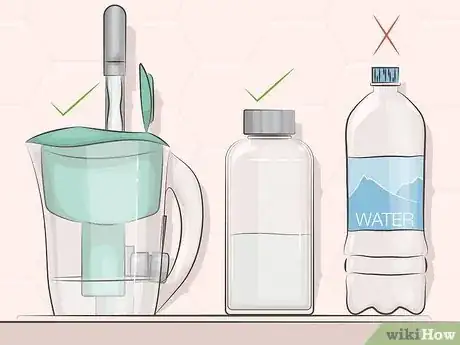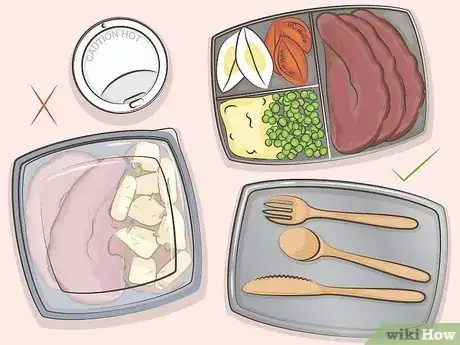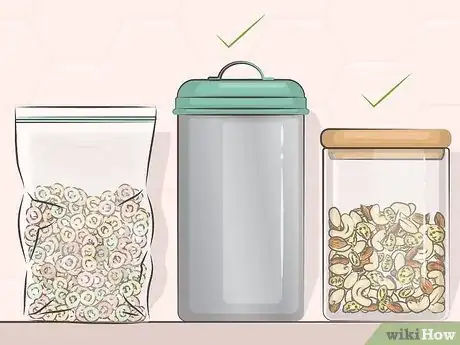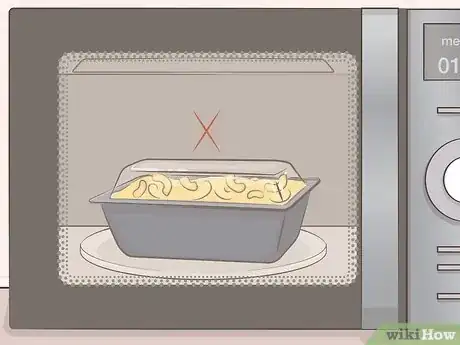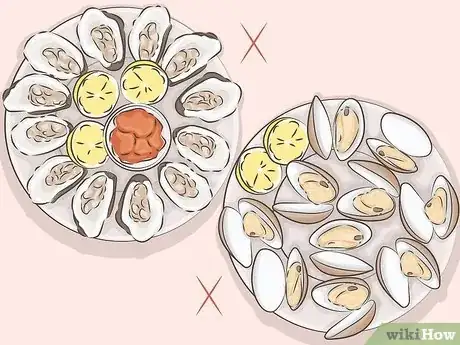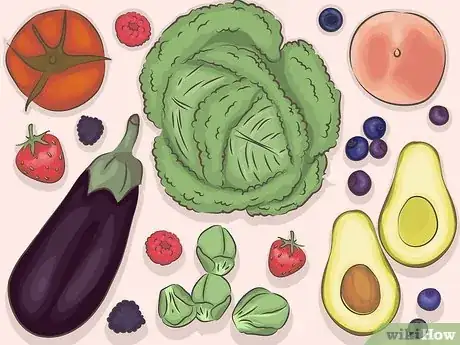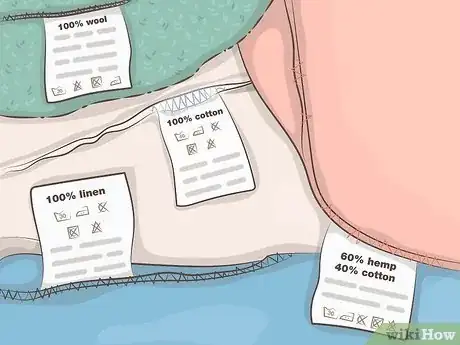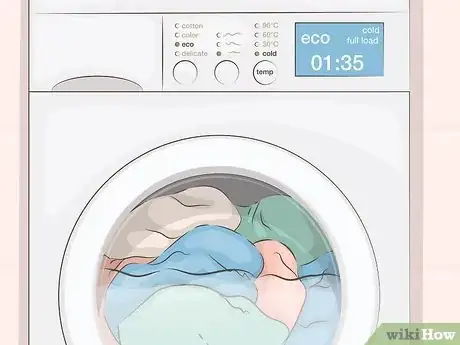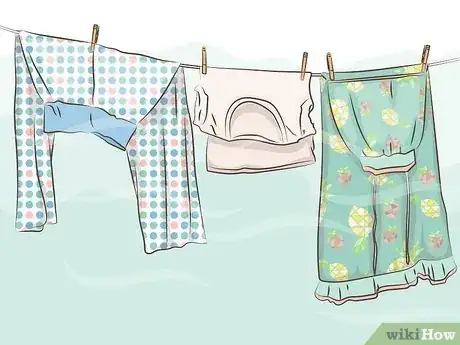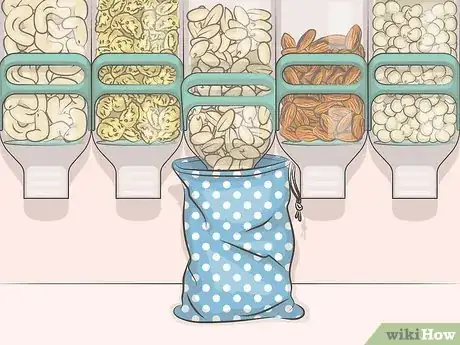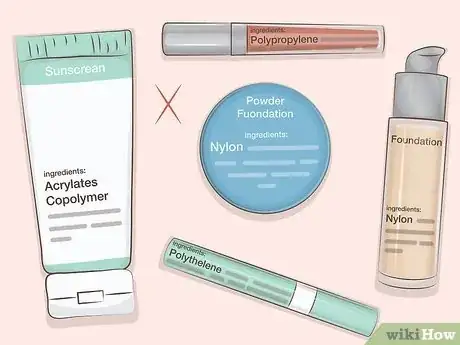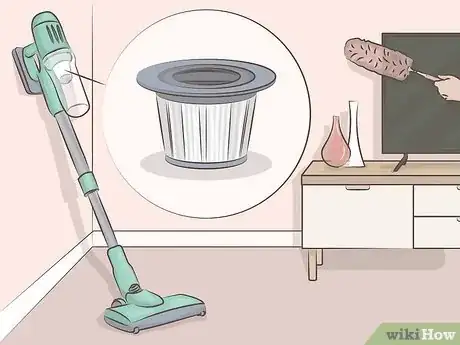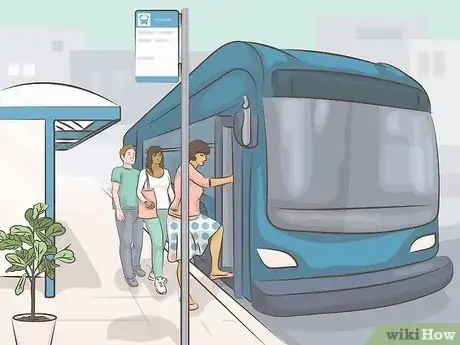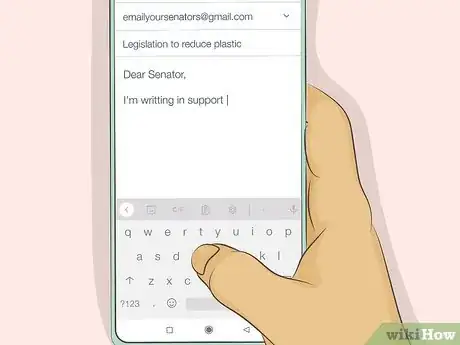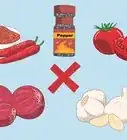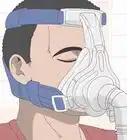This article was co-authored by wikiHow staff writer, Jessica Gibson. Jessica Gibson is a Writer and Editor who's been with wikiHow since 2014. After completing a year of art studies at the Emily Carr University in Vancouver, she graduated from Columbia College with a BA in History. Jessica also completed an MA in History from The University of Oregon in 2013.
There are 13 references cited in this article, which can be found at the bottom of the page.
This article has been viewed 11,448 times.
Learn more...
Microplastics are a real concern—they seem to be found everywhere these days, from the arctic to deep in people's lungs. Everything that's made of plastic eventually breaks down into tiny microplastics that people breathe in, drink, and eat. Unfortunately, microplastics get into waterways and natural food chains, which can eventually lead them straight to your dinner plate. Luckily though, there are tons of easy steps you can take to avoid microplastics. In this article, we'll teach you how you can avoid them in your food and even help limit microplastic pollution in the environment. To learn more, read our complete guide below!
Things You Should Know
- As plastic breaks down, it turns into microplastics—or, plastic particles that can cause health problems in humans and animals.[1] X Trustworthy Source PubMed Central Journal archive from the U.S. National Institutes of Health Go to source
- Cutting back on plastic production reduces microplastics in the environment (which leads to less microplastics ingested by people, too!).
- In general, the best way to limit your exposure to microplastics is to avoid processed and plastic-packaged foods.
Steps
Drink filtered tap water.
-
Tap water contains less microplastic than plastic water bottles. This is especially if you filter your water. If you're in the habit of picking up bottled water when you go out, make the switch to a reusable bottle and fill it up with filtered tap water throughout the day. You'll save money and reduce your microplastic intake![2] X Trustworthy Source Consumer Reports Nonprofit organization dedicated to consumer advocacy and product testing Go to source
- In a large study on microplastics in bottled water, researchers found microplastic in 93% of the samples they tested.[3] X Trustworthy Source PubMed Central Journal archive from the U.S. National Institutes of Health Go to source This means you're more likely to drink microplastics if you drink from a plastic water bottle than if you drink filtered tap water.
Avoid single-use packaging.
-
Bring your own reusable cutlery and takeout containers. When hot food comes into contact with plastic to-go containers, more of the chemicals leach into your food. The same goes for your morning cup of coffee from a disposable cup, which is lined with plastic. To avoid microplastics in your food, bring your own bamboo utensils or cutlery and have metal or glass containers to package your food.[4] X Research source
- If you place a takeout order, tell them you'll bring your own containers when you pick the food up.
- Plastic utensils are used for an average of 3 minutes, but the plastic breaks down in the environment for hundreds of years.
Store your food in metal or glass containers.
-
Avoid keeping your food in plastic wrap, plastic bags, or plastic containers. When your food comes into contact with plastic for an extended period of time, it's more likely to absorb chemicals from the plastic. Instead, reach for metal or glass containers, and try beeswax wrap instead of plastic wrap.[5] X Trustworthy Source Consumer Reports Nonprofit organization dedicated to consumer advocacy and product testing Go to source
- To cut back on plastic wrap, get creative with plates—if you cut a lemon or onion in half, turn it upside down so it sits flat on a dish. Then, stick it in the fridge. No need for plastic.
Avoid microwaving plastic and microwavable meals.
-
Microwaving food in plastic causes the plastic to break down faster. It's much safer to put your food into a glass or ceramic dish and microwave it. Avoid eating frozen pre-packaged meals that you heat in the microwave. These foods have been in contact with plastic for a long time and heating them up in the plastic can release microplastic into the food.[6] X Trustworthy Source Consumer Reports Nonprofit organization dedicated to consumer advocacy and product testing Go to source
Limit your intake of seafood, especially shellfish.
-
Fish and bivalves like clams and oysters consume plastic in the ocean. When you eat seafood, you ingest those microplastics. While all seafood is exposed to microplastics, mussels and oysters have some of the highest levels.[7] X Trustworthy Source PubMed Central Journal archive from the U.S. National Institutes of Health Go to source
- If you like seafood and don't want to give it up entirely, you might choose to skip bivalves and enjoy fish once in a while.
Eat more fresh, whole food.
-
Cut back on processed foods since they contain more microplastics. "Processed foods" are usually made in a factory (and typically, they'll have a super long ingredient list). Ultra-processed foods like chips, fast food, fries, and frozen meals contain higher levels of microplastics that break down into phthalates—chemicals that can contribute to chronic disease.[8] X Research source To play it safe, stick with unprocessed or minimally processed food.[9] X Research source
- You may have heard that some produce, like apples and carrots, contains microplastics. While this is true, fresh produce still contains fewer microplastics than processed convenience foods.
- Tea steeped in bags is actually high in microplastics, so switch to loose leaf tea.
Shop for clothes made from natural fibers.
-
Synthetic fibers shed microplastics every time you wash them. In fact, textiles are one of the biggest contributors to microplastic pollution. Read labels when you shop for clothes, sheets, or blankets, and avoid buying synthetic materials—polyester, acrylic, nylon, spandex, rayon, and microfiber. Instead, get cotton, wool, hemp, or linen products.[10] X Research source
- If you can't afford natural fibers, check out secondhand shops. Even if you can't find natural fibers there, buying synthetic clothes from a thrift store is better than buying them brand new.
Wash your clothes on a cool, efficient cycle.
-
Wait until you have a full load to run, so fewer microplastics are released. Set the machine to run a low-water or energy-efficient cycle using cold or cool water. If you don't have an energy-efficient option, wash your clothes on a short cycle to minimize the amount of time that your clothes rub against each other, releasing microplastics.[11] X Research source
Air dry your clothes instead of using a dryer.
-
Drying your clothes in a machine releases thousands of microplastics. A simple way to drastically cut back on microplastics is to hang your clothes on a line or drying rack to air dry. Your clothes will last longer, too![12] X Trustworthy Source PubMed Central Journal archive from the U.S. National Institutes of Health Go to source
- Researchers found that running a load of laundry through the dryer released microfibers 30 feet (9.1 m) away from the vent—directly into the environment.
Shop sustainably to avoid plastic packaging.
-
Head to the bulk bins and use your own cloth bags. Packaging is a huge contributor to microplastic pollution—just look at your weekly grocery haul. The next time you shop, see what foods you can buy from the bulk bins and bring your own cloth bags. Many stores offer a discount for bringing your own bags, so you'll reduce your plastic consumption and save a little money.[13] X Trustworthy Source Consumer Reports Nonprofit organization dedicated to consumer advocacy and product testing Go to source
- If you have to buy food that's in plastic, avoid containers with the codes 3 and 6 since these are more harmful than codes 2, 4, and 5.
- Code 3 plastic is PVC, which leaches phthalates—a chemical that disrupts your hormones.
- Code 6 plastic is polystyrene or styrofoam, which breaks up really easily into microplastics. It's also a probable carcinogen.[14] X Research source
Use plastic-free cosmetics and personal products.
-
Read labels and avoid items that contribute to microplastic runoff. While microbeads have been banned since 2015, microplastics are still in a lot of cosmetics, toothpaste, and skincare products. Shop around and pass on products that contain these plastics:[15] X Research source
- Polythelene
- Polypropylene
- Nylon
- Polymethyl methacrylate
- Acrylates Copolymer
Vacuum and dust frequently.
-
Dust actually contains microplastics, so keep your home clean! Wipe down surfaces in your home and vacuum before you actually notice dust or you may breathe in more microplastics.[16] X Trustworthy Source Consumer Reports Nonprofit organization dedicated to consumer advocacy and product testing Go to source
- For the best results, use a vacuum with a HEPA filter.
- You may have been told to dust with a microfiber cloth, but microfiber cloths are a huge source of microplastics. Reach for old sheets, towels, or clothes to use as dusting rags instead.
Take public transportation.
-
Driving your car causes the tires to break down and release microplastics. This is why cities or areas with traffic congestion have higher pollution. Tire erosion contributes to something called "city dust"—a mix of microplastics from tires, household plastics, and industrial plastic use. To minimize microplastics, use public transit whenever you can to reduce tire erosion.[17] X Research source
- If it's not feasible for you to take public transit, ride your bike instead or carpool with neighbors and co-workers.
- If you have to drive, combine your errands, so you're being more efficient about driving.
Support legislation to reduce plastic use.
-
Read up on relevant legislation and urge representatives to pass it. Pay attention to plastics in politics at the federal, state, and local levels. Call or email your senators and representatives to let them know that reducing plastic production and use is important to you.[18] X Research source
- If you're unhappy with the steps your legislators may or may not be taking, start your own grassroots movement to reduce microplastics in your community. You might just be the change your community needs!
You Might Also Like
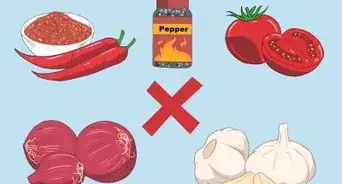 How to Get Rid of Hiccups
How to Get Rid of Hiccups
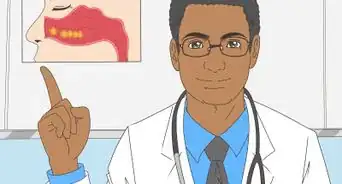

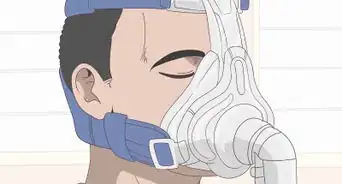

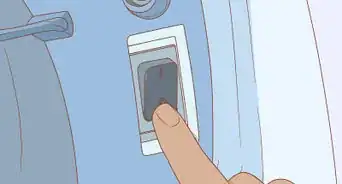
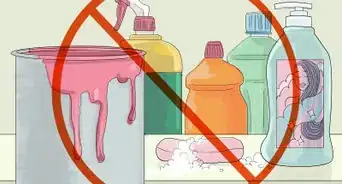
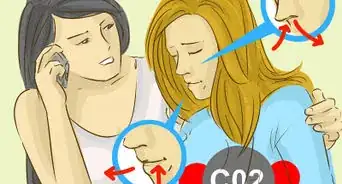
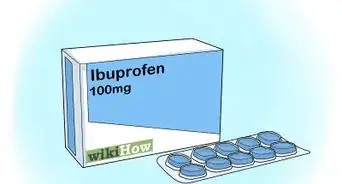
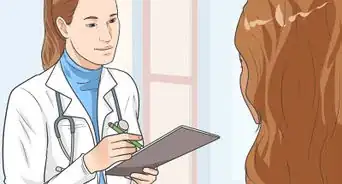
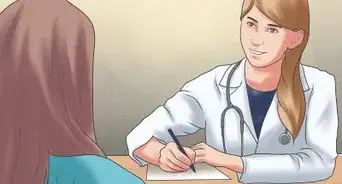
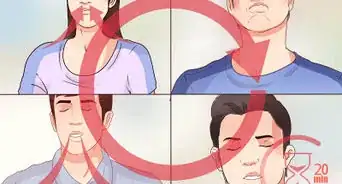
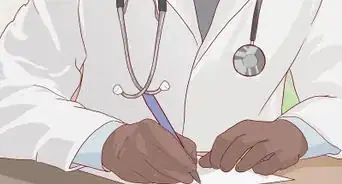
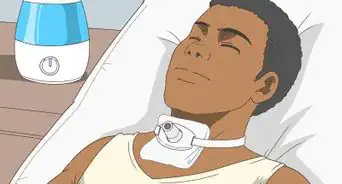
References
- ↑ https://www.ncbi.nlm.nih.gov/pmc/articles/PMC7068600/
- ↑ https://www.consumerreports.org/health-wellness/how-to-eat-less-plastic-microplastics-in-food-water-a8899165110/
- ↑ https://www.ncbi.nlm.nih.gov/pmc/articles/PMC6141690/
- ↑ https://www.nhm.ac.uk/discover/what-are-microplastics.html
- ↑ https://www.consumerreports.org/health-wellness/how-to-eat-less-plastic-microplastics-in-food-water-a8899165110/
- ↑ https://www.consumerreports.org/health-wellness/how-to-eat-less-plastic-microplastics-in-food-water-a8899165110/
- ↑ https://pubmed.ncbi.nlm.nih.gov/26386204/
- ↑ https://www.sciencedirect.com/science/article/pii/S0160412019317416?via%3Dihub
- ↑ https://sustainablereview.com/easy-ways-to-reduce-your-exposure-to-microplastics/
- ↑ https://www.uhhospitals.org/Healthy-at-UH/articles/2022/07/what-are-microplastics-and-how-can-you-reduce-your-risk
- ↑ https://www.bbc.co.uk/bitesize/articles/znfw7yc
- ↑ https://www.ncbi.nlm.nih.gov/pmc/articles/PMC7540867/
- ↑ https://www.consumerreports.org/health-wellness/how-to-eat-less-plastic-microplastics-in-food-water-a8899165110/
- ↑ https://uspirg.org/news/usp/world-health-organization-finds-increased-cancer-risk-chemical-found-plastics
- ↑ https://www.beatthemicrobead.org/guide-to-microplastics/
- ↑ https://www.consumerreports.org/health-wellness/how-to-eat-less-plastic-microplastics-in-food-water-a8899165110/
- ↑ https://www.uhhospitals.org/Healthy-at-UH/articles/2022/07/what-are-microplastics-and-how-can-you-reduce-your-risk
- ↑ https://www.oceanicsociety.org/resources/7-ways-to-reduce-ocean-plastic-pollution-today/
About This Article

